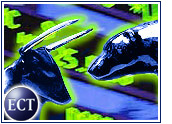
Perhaps the technology sector is more resilient than Ithought.
Some economists already refer to the recession in thepast tense, and analysts are eagerly shortening theirrecovery timelines.
This week, for example, Forrester Research said the tech sectorwill return to double-digit annualgrowth by 2003.
Call me pessimistic, but that sounds like wishfulthinking. Even with an upturn in sight, we shouldremain on guard for bumps in the road ahead.
Light Ahead
In the second half of 2002, the technology sector willgrow 3.9 percent, according to Forrester — nearly twopercentage points higher than the research firmpredicted in October 2001.
In 2003, Forrester said, growth will reach 10.4 percent, followedby 12.5 percent growth in 2004.
Those predictions may be accurate. But thetrajectory of growth will not be without some dips andvalleys.
Ups and Downs
Many economists will tell you that the path ofeconomic recovery often takes the shape of a “W.” Thatis, after a stint of growth, another mini-contractionoccurs before giving way to a legitimate recuperation.
I would not be surprised to see this scenario play outin coming months. And I expect thetechnology sector to track closely along this path.
Since the recession was largely spearheaded by thebusiness-to-business (B2B) arena, rather than by the consumer sector, wemay find cautionary clues in corporate technology spending behavior.
On Your Mark
No single company wants to be the first to bid farewell to the economic doldrums and launch aggressive growth plans.
It will take much more than a few encouraging wordsfrom analysts or Mr. Greenspan to rekindlecorporate IT spending.
So for the next six to nine months, there will be alot of waiting and posturing among technologycompanies, which will behave like thoroughbreds before a starting gun.
This will undoubtedly delay, or perhaps even stall, therecovery.
Not So Fast
Once companies begin to loosen their grip on cash,they will invest judiciously, looking for discernablereturns that are months, not years, away.
The days of strategic technology investments made forcompetitive or marketing reasons are over.
Many firms will try to build on existing investmentsin enterprise resource planning and customerrelationship management systems, rather than makingnew commitments to e-procurement or e-marketplaceapplications.
Therefore, IT spending as a whole will ramp upsporadically over the next year.
Integration Challenges
The need to integrate efficiently with tradingpartners will draw companies toward the promise ofWeb Services, which purportedly will allow data topass seamlessly from one application to another,reducing costly lags in the supply chain.
Clearly, new opportunities for value creation willemerge, making room for new technologies and vendors.
The problem is that there are still many lessons to belearned and best practices to be developed in WebServices.
As a result, companies undoubtedly will make someinvestment mistakes and surrender some money on theirway up the learning curve — just as they did inthe e-marketplace era.
This represents another bump in the road back from recession– perhaps the penultimate leg of the “W.”
Rite of Passage
As we inch closer to mid-year, pessimists andoptimists likely can agree on one fact: Theinfancy of the Internet and of e-commerce is all but over.
And whether they follow a straight or jagged course, keytechnologies like e-commerce and e-collaboration areapproaching the prosperous years of young adulthood.
Note: The opinions expressed by our columnists are their own and do not necessarily reflect the views of the E-Commerce Times or its management.
























































Social Media
See all Social Media